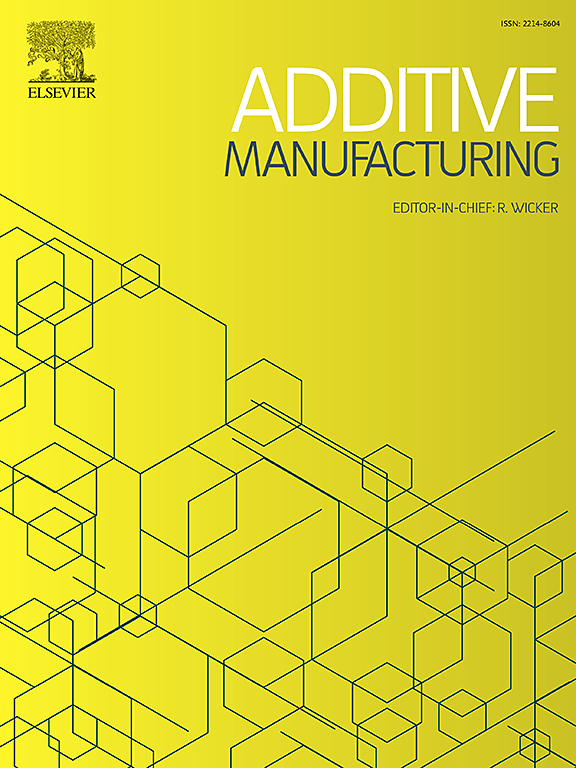Mechanical properties of particle-bed 3D printed concrete infill patterns
IF 11.1
1区 工程技术
Q1 ENGINEERING, MANUFACTURING
引用次数: 0
Abstract
The particle-bed printing technique utilizes unbound material as support during the printing process, enabling the creation of complex 3D patterns that extrusion-based printing method cannot achieve. This study uses the selective paste intrusion particle-bed printing technique to produce specimens, including various prisms and cylindrical shapes with gyroid, diamond, and I-WP infill patterns, along with full cylinders, printed in various orientations. Three-point bending tests are conducted on the prisms to evaluate tensile, compressive, and fracture properties, while uniaxial compression tests are performed on the cylinders to assess the compressive properties. The compressive tests on the infill cylinders indicate that relationships between infill density and compressive properties follow a power-law function, consistent with similar patterns observed in other materials. Cracking primarily occurs at locations where the angle between unit cell faces approaches zero. These positions create an aggregation of surfaces that effectively bridge the internal structure, facilitating load transfer within the concrete. This study investigates the mechanical properties of particle-bed printed specimens, focusing on the compressive behavior of complex 3D concrete infill patterns featuring overhangs. These intricate geometries, fabricated for the first time using concrete particle-bed printing, are analyzed to evaluate how varying design parameters, such as printing direction and infill density, influence compressive performance. The relationships between infill density and compressive properties are systematically quantified across different infill patterns, providing valuable insights for structural design and topology optimization.
颗粒床3D打印混凝土填充图案的力学性能
颗粒床打印技术在打印过程中利用未绑定材料作为支撑,可以创建基于挤出的打印方法无法实现的复杂3D图案。本研究采用选择性膏体侵入颗粒床打印技术,制作了各种形状的样品,包括棱柱形状的陀螺、菱形和I-WP填充图案,以及以各种方向打印的全圆柱体。在棱镜上进行三点弯曲试验,以评估拉伸、压缩和断裂性能,而在圆柱体上进行单轴压缩试验,以评估压缩性能。对填充柱的压缩试验表明,填充密度与压缩性能之间的关系遵循幂律函数,这与在其他材料中观察到的类似模式一致。开裂主要发生在单元胞面之间的夹角接近于零的位置。这些位置创造了一个表面的集合,有效地连接了内部结构,促进了混凝土内部的荷载传递。本研究研究了颗粒床打印试件的力学性能,重点研究了具有悬垂特征的复杂3D混凝土填充模式的压缩行为。这些复杂的几何形状是首次使用混凝土颗粒床打印制造的,研究人员对其进行了分析,以评估不同的设计参数(如打印方向和填充密度)如何影响抗压性能。在不同的填充模式下,系统地量化了填充密度和压缩性能之间的关系,为结构设计和拓扑优化提供了有价值的见解。
本文章由计算机程序翻译,如有差异,请以英文原文为准。
求助全文
约1分钟内获得全文
求助全文
来源期刊

Additive manufacturing
Materials Science-General Materials Science
CiteScore
19.80
自引率
12.70%
发文量
648
审稿时长
35 days
期刊介绍:
Additive Manufacturing stands as a peer-reviewed journal dedicated to delivering high-quality research papers and reviews in the field of additive manufacturing, serving both academia and industry leaders. The journal's objective is to recognize the innovative essence of additive manufacturing and its diverse applications, providing a comprehensive overview of current developments and future prospects.
The transformative potential of additive manufacturing technologies in product design and manufacturing is poised to disrupt traditional approaches. In response to this paradigm shift, a distinctive and comprehensive publication outlet was essential. Additive Manufacturing fulfills this need, offering a platform for engineers, materials scientists, and practitioners across academia and various industries to document and share innovations in these evolving technologies.
 求助内容:
求助内容: 应助结果提醒方式:
应助结果提醒方式:


